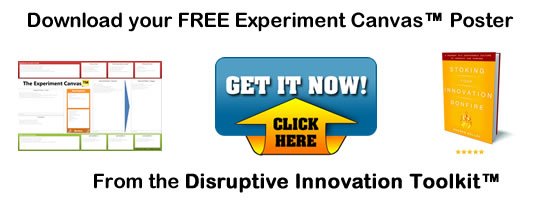4 Things Successful Leaders Say to Create a Culture of Innovation

In my 25 years of playing in the innovation space and partnering with both Fortune 500 and start-ups, I’ve come to realize that the most successful leaders say “I’m wrong†more than they say “I’m right.†Truly successful leaders that seek to build a culture where innovation thrives don’t try to have all the answers. In fact, it’s their willingness to recognize other perspectives and the openness to new thinking, that makes them successful leaders. It’s what allows them to find the most innovative answers. It’s easy to fall into the trap of believing that being an innovator or in a role of leadership is about having all the answers. Turns out, the opposite is true.
Here are the four phrases I’ve come to recognize from true successful leaders.
1. I’m Wrong
That’s a hard one to say. Most people take admitting their mistakes as a personal failure. As if being wrong makes them wrong, as a person. Your ego wants to protect itself and admitting you are wrong puts a big dent in your fragile “id.†But innovation takes mistakes, sometimes lots of them.
Mistakes mean you are learning and growing. It means you’ve tried a lot and some things worked and some didn’t. Without mistakes, we wouldn’t have laundry detergent or Sticky Notes.
An innovator knows that saying “I’m wrong†is one of the most powerful phrases. In fact, it’s the confident person that can admit their mistakes, learn from them, and evolve. It’s the most insecure that try to be right and hide mistakes at all costs.
If you want to be an innovator and a leader, recognize that it’s not only ok to be wrong, it’s expected.
If you are an innovator or leader that is “right all along†or says “I always knew it,†I’d question whether you have a severe case of tunnel vision. Edison was wrong 1,000 times before he figured out the light bulb.
2. Tell Me More About That
Years ago, I closed on the biggest innovation engagement of my young career. I was only 32 and the deal was worth a quarter of a million dollars. When I heard the client on the other end of the phone say, “we’d love to work with your company, and specifically you Tamara†I was blown away. Later, once I felt like the client and I had a strong rapport, I braved the question “What made you decide to go with us?â€
He told me something I’ll never forget. He said, “Tamara, all the other leaders in innovation we talked to were quick to jump to solutions. They had an answer to every question we asked. We couldn’t even take a breath before they jumped in. You, on the other hand, would pause and instead of answering the question, you kept saying back to us, ‘Tell me more about what makes you ask that?’ or ‘that’s an interesting question, what makes you ask?’ We got more clarity and more insight in those moments than in the solutions everyone else provided. It was as if your desire to uncover the ‘why’ for yourself helped us do the same. That’s why we enthusiastically hired you.â€
Often times as innovators or leaders you think you have to be the solution person. The minute someone asks a question, you should jump to the answer. But what I’ve learned over the years is that the “why†behind the question is more powerful and more insightful than the question itself.
If you want to be a successful leader, one that ignites a culture of innovation, get into the habit of pausing and asking a question of their question. You’ll be amazed at what you learn.
3. I Don’t Know
Much like “I’m wrong,†I don’t know is hard for many innovators and leaders to say. Again, you are supposed to know everything, aren’t you? Of course not, that’s why we have teams, hire experts, and seek advice. Nobody has all the answers. What you do have is the ability to find out the answer.
I was in a meeting with the vice presidents at a major consumer packaged goods company. There were at least 10 of us in the room discussing the direction of the brands and products they each ran, totaling over 750 million in annual sales.  As we went around the room sharing, each VP gave a confident sounding and clear answer to why their businesses were lagging or thriving… until Doug. Doug looked around the room and with a clear head and just as much confidence as everyone else, said, “I don’t know.†Then he followed it up with, “we’ve had this crazy spike up and down in our performance. So instead of coming up with the answer today, we decided to take a step back and dedicate time and resources to understanding why so we can move forward correctly. But until we dig in, I don’t know.â€
Wow! Can you imagine being in a room with all your peers, the people you are judged against, the people who seemingly have the answer, and admitting “I don’t know�
Here’s the interesting thing that happened next. It was as if a collective sigh of relief swept across the room. First Jennifer, at the other end of the table, spoke up and said, “You know, we aren’t totally sure about why our dip in the Midwest was so big.†And then Peter piped in with “I wish we knew more.†Soon almost everyone in the room was admitting their lack of knowledge.
Later many of the VPs admitted to me that that was the most productive meeting they’d ever had. They said it freed them up to drop the “show boating†and focus on the work that needed to be done – figuring out what they don’t know.
“I don’t know†is vulnerable and real. It doesn’t show insecurity, in fact quite the opposite. It shows confidence. Confidence that it’s ok not to know something. Confidence in your ability to figure it out. Doug was one of the most confident leaders with the most innovative answers I have ever met and he often said, “I don’t know.†And then he followed it up with how he was going to find out.
“I don’t know†and the curiosity to find out is a powerful leadership tool for real innovators.
4. I want to share something personal with you.
Be professional…
Leave your personal life at home…
Don’t get mushy at work…
We hear those phrases all the time. But I witnessed something this week that proved to me the power of being personal with people. I had the good fortune of being the only outside keynote speaker for the annual meeting of a national restaurant chain. It was an incredible multi-day experience that was all brought home with the final talk from the CEO. Instead of wrapping up the 2 days of business progress reports and future business presentations with more business, she got all personal. She shared an incredibly personal story about resilience. You could feel the vulnerability from the stage and you could feel the connect happening with all 1,000 employees in the room. Not because her story was or wasn’t relatable to them. Rather, by sharing something incredibly personal she built a human connection. Looking around the room, I could see the warmth, respect, and the engagement in their work elevate with every sentence of her story.
At the end of the day, we are all just people trying to get by. We all have our experiences, our stories, and our baggage. We are all seeking connection. It’s human nature to want to be communal, even for the most individualistic solo wolves (myself included). And we want our leaders to show the same vulnerability and connection too. I’m not saying you shouldn’t get down to business and I’m definitely not saying work is chatty time. What I am saying is to bring the whole you to work.
Just because you are a leader doesn’t mean you suddenly can’t bring your whole self to work. In fact, it’s a mandate that you, more than anyone else, should because you set the tone. If you want to motivate people to follow you to the ends of the earth, get personal with them.
Clients often tell me that their favorite micro-learning videos on our On Demand platform have to do with being open to new thinking, being willing in challenging assumptions and overcome the biases that hold them back. Don’t be afraid to put yourself out there. Leadership and innovation requires vulnerability, courage, and openness.
Wait! Before you go…
Choose how you want the latest innovation content delivered to you:
- Daily — RSS Feed — Email — Twitter — Facebook — Linkedin Today
- Weekly — Email Newsletter — Free Magazine — Linkedin Group
 Tamara Ghandour of GoToLaunchStreet is a TED speaker and entrepreneur. From building and running multimillion dollar businesses, advising Fortune 500 like Disney, Procter and Gamble and RICOH on fostering innovative ideas and people. Tamara’s life is about breaking through the status quo for game-changing results, and that’s what her keynotes, online programs and assessments can do for you.
Tamara Ghandour of GoToLaunchStreet is a TED speaker and entrepreneur. From building and running multimillion dollar businesses, advising Fortune 500 like Disney, Procter and Gamble and RICOH on fostering innovative ideas and people. Tamara’s life is about breaking through the status quo for game-changing results, and that’s what her keynotes, online programs and assessments can do for you.
NEVER MISS ANOTHER NEWSLETTER!
LATEST BLOGS
Three things you didn’t know about credit cards
Photo by Ales Nesetril on Unsplash Many of us use credit cards regularly. From using them for everyday purchases to…
Read MoreFive CV skills of a business-minded individual
Photo by Scott Graham on Unsplash The skills listed on a CV help employers quickly understand your suitability for a…
Read More


